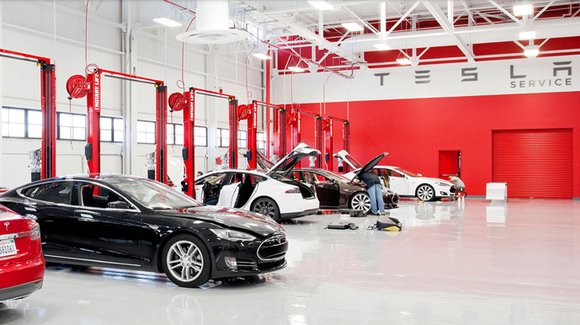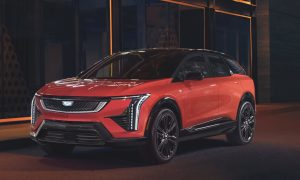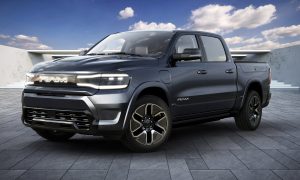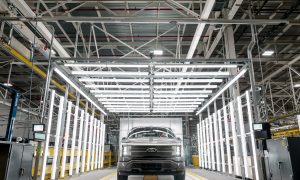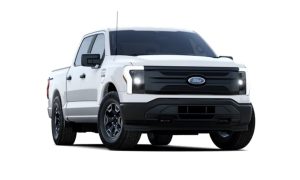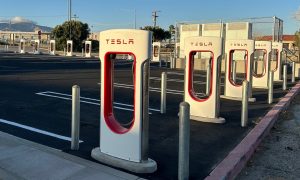News
How Tesla Challenges Other Car Makers
Tesla challenges other car makers to build better cars says Diarmuid O’Connell, Telsa’s vice president of business development at an industry conference.
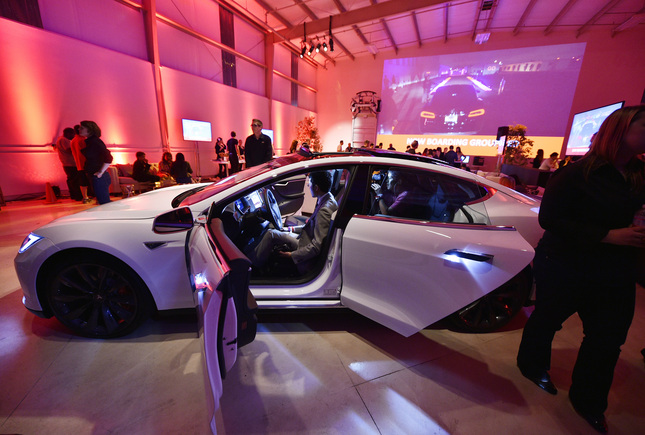
Diarmuid O’Connell, Tesla’s VP of business development, had harsh words for competitors last week at the CAR management briefing seminars in Michigan. He told the group that Tesla challenges other car makers to build better cars.
“You can split the market of EVs into two programs,” he said. “Many are compliance programs. Exceptions are Nissan, ourselves and BMW. Most are focused on minimum compliance, lowest common denominator behavior, and the vehicles reflect that. In some respect, they are appliances, in terms of the way they look.”
CARB And The EPA
His remarks come at a time when two important regulatory programs are up for review. The California Air Resources Board is taking a look at its zero emissions vehicle policies and the Environmental Protection Agency is considering changes to its CAFE standards.
Traditional car makers are trying to get both agencies to relax those standards, but O’Connell says they should stop trying to “slow walk” the rate of progress toward a emissions free future and get busy building better cars. He says his company wants California and the EPA to raise their standards, not relax them.
“From an empirical standpoint, the [regulations] are very weak, eminently achievable and the only thing missing is the will to put compelling products on the road,” he said, according to The Wall Street Journal.
This week, Mary Nichols, CARB chairwoman since 2007, announced that she isn’t satisfied with having just a few electric cars on California roads. The current standard calls for 2.7% of all cars sold in California to be electric. Nichols wants to set the bar higher. In fact, she would like it if all the cars sold in California were electric by 2030.
For its part, the automotive industry is busy telling the EPA that the current CAFE standards are too high. Any further tightening would be bad for business. “We need consumers to buy them in high volumes to meet the steep climb in fuel economy standards ahead,” the Alliance of Automobile Manufacturers, an industry lobbying group, told the conference. The implication is that higher standards will kill the automotive business, cause massive layoffs, and have a negative impact on the economy.
This is precisely the same argument the automobile industry made about safety related changes in the ’50’s, seat belts in the 60’s, exhaust emission in the 70’s, airbags in the 90’s and better crash test performance at the beginning of the 21st century. Its complaints today are just more of the same.
CAFE Olay
The furor over EPA standards is actually a tempest in a teapot. On the surface of it, the 54.5 mpg requirement by 2025 seems like a huge increase above present day performance. But in reality, that standard is based on the old EPA mileage testing protocol, which was amended several years ago because it resulted in numbers that were wildly optimistic.
When the EPA adopted a new standard designed to better reflect real world expectations, it did not apply the new standard to the computation of the 2025 goal. If it did, that 54.5 mpg number would convert to around 37 mpg — which many of today’s cars are already capable of achieving.
To suggest that car companies cannot achieve a CAFE of 37 mpg using the current EPA protocol is patently absurd. In fact, a representative of Johnson Controls, one of the largest suppliers of components to the automobile manufacturing , said last year that car makers can easily meet the new standard and, in fact, many are already doing so today with internal combustion cars.
Charging Technology
One area where other manufacturers need to step up involves recharging technology for EVs and plug-in cars. At present, the best any of those other cars can handle is 50 kW. Tesla already has Superchargers with more than double that capacity. It’s new liquid cooled charging cables indicate the company has even higher power chargers in mind for the future.
O’Connell told the conference that drivers of competitors’ cars would be welcome to use the Supercharger network if only their cars were capable of handling the higher current. Tesla made its Supercharger patents public last year, but no other manufacturer has expressed any interest in them. Instead, the industry seems content to live with 50 kW “fast chargers” that really aren’t all that fast.
The Week In Review
Tesla has had a rough week. The stock market was disappointed with what Elon Musk had to say during the 2nd quarter conference call and punished the company’s stock, which closed down nearly 9% for the week.
The real question on people’s minds is whether Tesla will bring electric cars to the masses the way the Model T put the world on wheels almost a century ago, or whether it is a company that caters only to the wealthy and will flame out the way the Concorde SST did? If you are reading this, chances are we know how you would answer that question.
Elon Musk
Tesla Supercharger Diner food menu gets a sneak peek as construction closes out
What are you ordering at the Tesla Diner?

The Tesla Supercharger Diner in Los Angeles is nearing completion as construction appears to be winding down significantly. However, the more minor details, such as what the company will serve at its 50s-style diner for food, are starting to be revealed.
Tesla’s Supercharger Diner is set to open soon, seven years after CEO Elon Musk first drafted the idea in a post on X in 2018. Musk has largely come through on most of what he envisioned for the project: the diner, the massive movie screens, and the intended vibe are all present, thanks to the aerial and ground footage shared on social media.
We already know the Diner will be open 24/7, based on decals placed on the front door of the restaurant that were shared earlier this week. We assume that Tesla Optimus will come into play for these long and uninterrupted hours.
The Tesla Diner is basically finished—here’s what it looks like
As far as the food, Tesla does have an email also printed on the front door of the Diner, but we did not receive any response back (yet) about what cuisine it will be offering. We figured it would be nothing fancy and it would be typical diner staples: burgers, fries, wings, milkshakes, etc.
According to pictures taken by @Tesla_lighting_, which were shared by Not a Tesla App, the food will be just that: quick and affordable meals that diners do well. It’s nothing crazy, just typical staples you’d find at any diner, just with a Tesla twist:
Tesla Diner food:
• Burgers
• Fries
• Chicken Wings
• Hot Dogs
• Hand-spun milkshakes
• And more https://t.co/kzFf20YZQq pic.twitter.com/aRv02TzouY— Sawyer Merritt (@SawyerMerritt) July 17, 2025
As the food menu is finalized, we will be sure to share any details Tesla provides, including a full list of what will be served and its prices.
Additionally, the entire property appears to be nearing its final construction stages, and it seems it may even be nearing completion. The movie screens are already up and showing videos of things like SpaceX launches.
There are many cars already using the Superchargers at the restaurant, and employees inside the facility look to be putting the finishing touches on the interior.
🚨 Boots on the ground at the Tesla Diner:
— TESLARATI (@Teslarati) July 17, 2025
It’s almost reminiscent of a Tesla version of a Buc-ee’s, a southern staple convenience store that offers much more than a traditional gas station. Of course, Tesla’s version is futuristic and more catered to the company’s image, but the idea is the same.
It’s a one-stop shop for anything you’d need to recharge as a Tesla owner. Los Angeles building permits have not yet revealed the date for the restaurant’s initial operation, but Tesla may have its eye on a target date that will likely be announced during next week’s Earnings Call.
News
Tesla’s longer Model Y did not scale back requests for this vehicle type from fans
Tesla fans are happy with the new Model Y, but they’re still vocal about the need for something else.

Tesla launched a slightly longer version of the Model Y all-electric crossover in China, and with it being extremely likely that the vehicle will make its way to other markets, including the United States, fans are still looking for something more.
The new Model Y L in China boasts a slightly larger wheelbase than its original version, giving slightly more interior room with a sixth seat, thanks to a third row.
Tesla exec hints at useful and potentially killer Model Y L feature
Tesla has said throughout the past year that it would focus on developing its affordable, compact models, which were set to begin production in the first half of the year. The company has not indicated whether it met that timeline or not, but many are hoping to see unveilings of those designs potentially during the Q3 earnings call.
However, the modifications to the Model Y, which have not yet been officially announced for any markets outside of China, still don’t seem to be what owners and fans are looking forward to. Instead, they are hoping for something larger.
A few months ago, I reported on the overall consensus within the Tesla community that the company needs a full-size SUV, minivan, or even a cargo van that would be ideal for camping or business use.
Tesla is missing one type of vehicle in its lineup and fans want it fast
That mentality still seems very present amongst fans and owners, who state that a full-size SUV with enough seating for a larger family, more capability in terms of cargo space for camping or business operation, and something to compete with gas cars like the Chevrolet Tahoe, Ford Expedition, or electric ones like the Volkswagen ID.BUZZ.
We asked the question on X, and Tesla fans were nearly unanimously in support of a larger SUV or minivan-type vehicle for the company’s lineup:
🚨 More and more people are *still* saying that, despite this new, longer Model Y, Tesla still needs a true three-row SUV
Do you agree? https://t.co/QmbRDcCE08 pic.twitter.com/p6m5zB4sDZ
— TESLARATI (@Teslarati) July 16, 2025
Here’s what some of the respondents said:
100% agree, we need a larger vehicle.
Our model Y is quickly getting too small for our family of 5 as the kids grow. A slightly longer Y with an extra seat is nice but it’s not enough if you’re looking to take it on road trips/vacations/ kids sports gear etc.
Unfortunately we…
— Anthony Hunter (@_LiarsDice_) July 17, 2025
Had to buy a Kia Carnival Hybrid because Tesla doesn’t have a true 3 row vehicle with proper space and respectable range. pic.twitter.com/pzwFyHU8Gi
— Neil, like the astronaut (@Neileeyo) July 17, 2025
Agreed! I’m not sure who created this but I liked it enough to save it. pic.twitter.com/Sof5nMehjS
— 🦉Wise Words of Wisdom – Inspirational Quotes (IQ) (@WiseWordsIQ) July 16, 2025
Tesla is certainly aware that many of its owners would like the company to develop something larger that competes with the large SUVs on the market.
However, it has not stated that anything like that is in the current plans for future vehicles, as it has made a concerted effort to develop Robotaxi alongside the affordable, compact models that it claims are in development.
It has already unveiled the Robovan, a people-mover that can seat up to 20 passengers in a lounge-like interior.
The Robovan will be completely driverless, so it’s unlikely we will see it before the release of a fully autonomous Full Self-Driving suite from Tesla.
Energy
Tesla launches first Virtual Power Plant in UK – get paid to use solar
Tesla has launched its first-ever Virtual Power Plant program in the United Kingdom.

Tesla has launched its first-ever Virtual Power Plant program in the United Kingdom. This feature enables users of solar panels and energy storage systems to sell their excess energy back to the grid.
Tesla is utilizing Octopus Energy, a British renewable energy company that operates in multiple markets, including the UK, France, Germany, Italy, Spain, Australia, Japan, New Zealand, and the United States, as the provider for the VPP launch in the region.
The company states that those who enroll in the program can earn up to £300 per month.
Tesla has operated several VPP programs worldwide, most notably in California, Texas, Connecticut, and the U.S. territory of Puerto Rico. This is not the first time Tesla has operated a VPP outside the United States, as there are programs in Australia, Japan, and New Zealand.
This is its first in the UK:
Our first VPP in the UK
You can get paid to share your energy – store excess energy in your Powerwall & sell it back to the grid
You’re making £££ and the community is powered by clean energy
Win-win pic.twitter.com/evhMtJpgy1
— Tesla UK (@tesla_uk) July 17, 2025
Tesla is not the only company that is working with Octopus Energy in the UK for the VPP, as it joins SolarEdge, GivEnergy, and Enphase as other companies that utilize the Octopus platform for their project operations.
It has been six years since Tesla launched its first VPP, as it started its first in Australia back in 2019. In 2024, Tesla paid out over $10 million to those participating in the program.
Participating in the VPP program that Tesla offers not only provides enrolled individuals with the opportunity to earn money, but it also contributes to grid stabilization by supporting local energy grids.
-

 Elon Musk1 day ago
Elon Musk1 day agoWaymo responds to Tesla’s Robotaxi expansion in Austin with bold statement
-

 News1 day ago
News1 day agoTesla exec hints at useful and potentially killer Model Y L feature
-

 Elon Musk2 days ago
Elon Musk2 days agoElon Musk reveals SpaceX’s target for Starship’s 10th launch
-

 Elon Musk3 days ago
Elon Musk3 days agoTesla ups Robotaxi fare price to another comical figure with service area expansion
-

 News1 day ago
News1 day agoTesla’s longer Model Y did not scale back requests for this vehicle type from fans
-

 News1 day ago
News1 day ago“Worthy of respect:” Six-seat Model Y L acknowledged by Tesla China’s biggest rivals
-

 News2 days ago
News2 days agoFirst glimpse of Tesla Model Y with six seats and extended wheelbase
-

 Elon Musk2 days ago
Elon Musk2 days agoElon Musk confirms Tesla is already rolling out a new feature for in-car Grok

